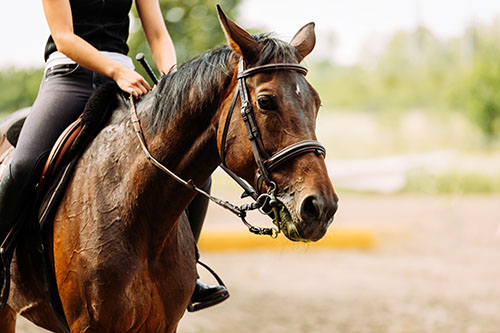Feeding a metabolically challenged horse
Sep 07, 2021

Equine metabolic disorders, including Metabolic Syndrome, Insulin Resistance, Cushing’s Disease, and Polysaccharide Storage Myopathy, have been “hot topics” in equine nutrition for more than a decade. Horses suffering from these disorders require diets low in non-structural carbohydrates (NSC). The primary types of non-structural carbohydrates found in horse diets are sugars, found in forages and starches, and in grains. For most metabolic horses, the diet should contain an NSC level of 10 percent or less.
How can you reduce the NSC content of your horse’s diet? Here are some tips:
25 (0.08) + 5 (0.17) = 2 + 0.85 = 2.85 lb. daily NSC intake
2.85 / 30 = 0.095, or 9.5% NSC
Limiting or eliminating pasture intake, choosing a hay that has been tested for NSC content, and feeding a low NSC feed to complement your hay will help you manage your metabolically challenged horse for optimum health and performance.
For more information on all things equine visit your local Co-op!
How can you reduce the NSC content of your horse’s diet? Here are some tips:
- Limit grazing.
- Either keep your horse on a dry lot or use a grazing muzzle to limit pasture intake. The NSC content of pasture forages varies by the hour and is affected by many factors, including the amount of sunlight, stage of maturity of the plant, plant species, and more. Because of this, it is safer to limit the horse’s intake all the time rather than trying to guess when a “safe” time to allow the horse to graze might be.
- Test your hay.
- Like a pasture, there are many environmental and management factors that impact the NSC content of a hay field. Testing allows you to know exactly what the NSC content of your particular hay is and makes feeding decisions based on this information.
- Try soaking hay.
- If you can’t find low NSC hay or aren’t sure of the NSC content of your hay, soaking is a simple method for reducing the NSC content. Hay should be soaked for 30-60 minutes, and the water should be drained and discarded before the hay is offered to metabolically challenged horses.
- Offer low-starch feeds.
- Choose a low NSC feed and be sure to feed it in accordance with the label directions. At TFC, we offer three low NSC feeds within our Pinnacle line to meet the needs of metabolic horses of all classes: Balancer (product #336PE), Low Starch (product #319PE), and Senior (product #323PE). The NSC content of the Balancer and Low Starch products is 13%, and the NSC content in the Senior product is 17%.
- You might be wondering why our low NSC feeds are above the 10% target for the diet of a metabolic horse. Remember the majority of a horse’s diet should be made up of forage (pasture or hay). For example, let’s look at an average 1200-pound horse in light work consuming about 25 pounds of hay per day and 5 pounds of our Pinnacle Senior product. If this horse is consuming a hay that has been tested at 8% NSC, then the NSC content of the total diet can be determined with some quick math:
25 (0.08) + 5 (0.17) = 2 + 0.85 = 2.85 lb. daily NSC intake
2.85 / 30 = 0.095, or 9.5% NSC
Limiting or eliminating pasture intake, choosing a hay that has been tested for NSC content, and feeding a low NSC feed to complement your hay will help you manage your metabolically challenged horse for optimum health and performance.
For more information on all things equine visit your local Co-op!